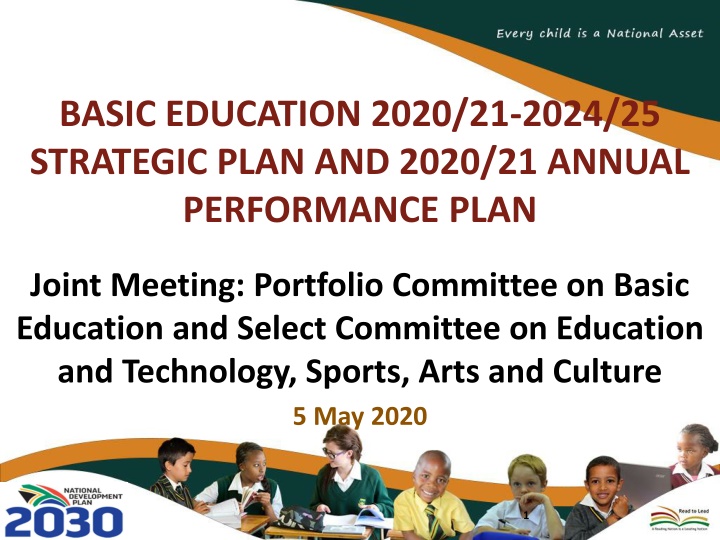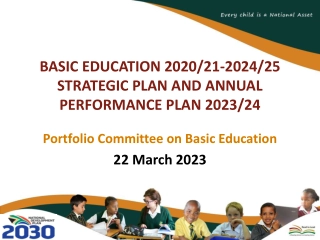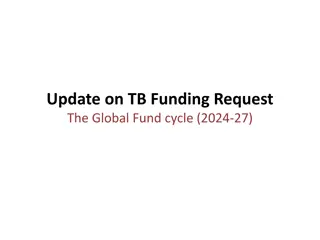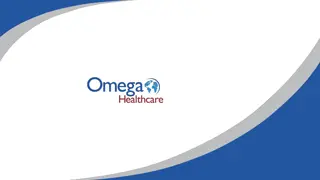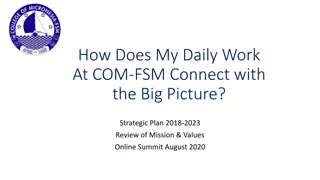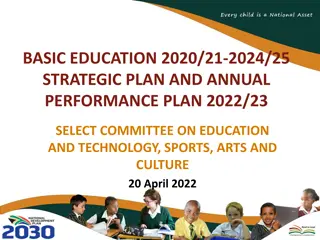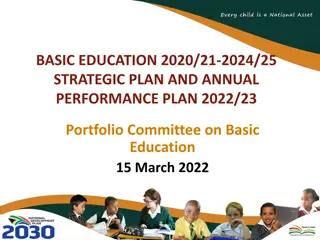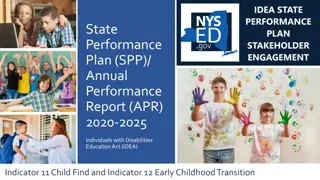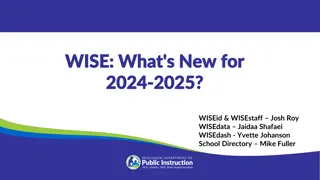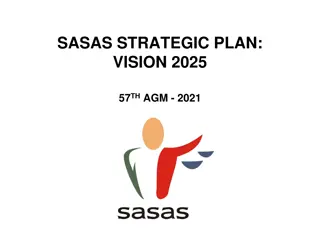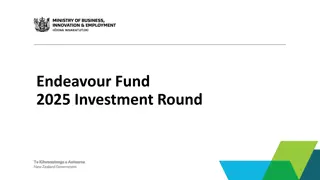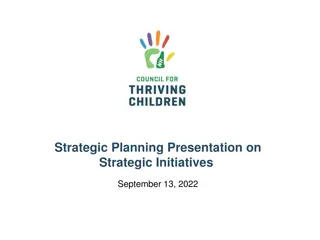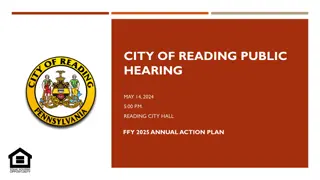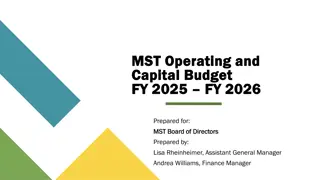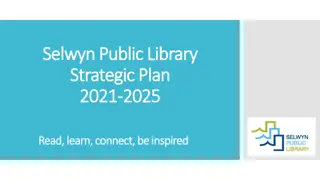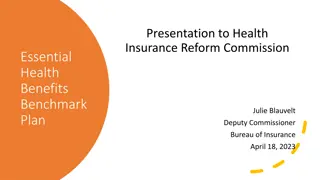Basic Education Strategic Plan 2020-2025 Presentation
This presentation outlines the strategic plan for basic education from 2020 to 2025, focusing on key objectives and initiatives. It was presented during a joint meeting of the Portfolio Committee on Basic Education and Select Committee on Education and Technology, Sports, Arts, and Culture on 5th May 2020.
Download Presentation

Please find below an Image/Link to download the presentation.
The content on the website is provided AS IS for your information and personal use only. It may not be sold, licensed, or shared on other websites without obtaining consent from the author.If you encounter any issues during the download, it is possible that the publisher has removed the file from their server.
You are allowed to download the files provided on this website for personal or commercial use, subject to the condition that they are used lawfully. All files are the property of their respective owners.
The content on the website is provided AS IS for your information and personal use only. It may not be sold, licensed, or shared on other websites without obtaining consent from the author.
E N D
Presentation Transcript
BASIC EDUCATION 2020/21-2024/25 STRATEGIC PLAN AND 2020/21 ANNUAL PERFORMANCE PLAN Joint Meeting: Portfolio Committee on Basic Education and Select Committee on Education and Technology, Sports, Arts and Culture 5 May 2020 1
PRESENTATION OUTLINE 1. 2. 3. 4. 5. 6. 7. 8. 9. 10. 11. 12. Purpose Introduction Size and Shape of the Basic Education Sector Background Progress on key selected deliverables Key Government Priorities Education Sector Medium-Term Strategic Framework (MTSF) State of the Nation Address (SoNA) Action Plan to 2024: Towards the realisation of schooling 2030 Education Sector Priorities 2020/21 Department of Basic Education (DBE) Annual Performance Plan (APP) development process Measuring our performance: 2020/21-2024/25 Strategic Plan and 2020/21 APP Impact Statement,Outcomes, Outputs, Indicators and Targets Department of Planning, Monitoring and Evaluation (DPME) analysis of the 2020/21 APP AGSA review of the 2020/21 APP 2020/21 APP monitoring activities affected due to Covid 19 and alternative mechanisms Budget Review: 2019/20 Audit Action Plan based on 2018/19 Audit findings: Finance and Performance Information Recommendations 13. 14. 15. 16. 17. 18. 2
PURPOSE To present the DBE Strategic Plan 2020/21-2024/25 Performance Plan 2020/21 to the Joint Meeting of the Portfolio Committee on Basic Education Committee on Technology, Sports, Arts and Culture. and Annual and Select and Education 3
INTRODUCTION By 2030, South Africans should have access to education and training of the highest quality, leading to significantly improved learning outcomes. The performance of South African learners in international standardised tests should be comparable to the performance of learners from countries at a similar level of development and with similar levels of access. National Planning Commission: National Development Plan, November 2011) 4
SIZE & SHAPE OF THE BASIC EDUCATION SECTOR 5
6 BASIC EDUCATION SECTOR Department of Basic Education (national) Provincial Education Departments (9) Education Districts (75) Circuit Offices (889) Schools (24 998) Independent (Private) schools (1 922) Public schools (23 076) Registered independent schools Unregistered independent schools (illegal) Section 21 Public Schools (former Model C) Section 20 Public schools Non-subsidised independent schools Subsidised independent schools Greater financial autonomy 6
EDUCATION STATISTICS AT A GLANCE, 2019 Size of the Schooling System: Sector Learners Educators Schools Public 407 001 23 076 12 408 755 Learners: 12 408 755 Educators: 407 001 Schools: 23 076 Independent 632 443 37 856 1 922 Total 13 041 198 444 857 24 998 Official languages Learners Educators Schools English, isiZulu, isiXhosa, isiNdebele, Afrikaans, siSwati, Sepedi, Sesotho, Setswana, Tshivenda, Xitsonga, South African Sign Language Public Independent Public Independent Public Independent 7
BACKGROUND The Annual Performance Plan (APP) sets out what the Department intends doing in the financial year and during the Medium-Term Expenditure Framework (MTEF) period to implement its Strategic Plan. In fulfilling its legal obligation, the Department must produce and table an APP annually to Parliament. The Strategic Plan should cover a period of at least five years and can be amended during the five-year period it covers. The 2020/21 APP represents the first year of activities towards achieving the objectives contained in the DBE Strategic Plan 2020/21-2024/25. The DBE s Strategic Plan is anchored on the Government s long-term plan; the National Development Plan 2030: Our future make it work, the MTSF 2019-2024 and the draft Action Plan to 2024. 8
PROGRESS ON SELECTED KEY DELIVERABLES 9
PERFORMANCE OF THE CLASS OF 2019 NSC 2019 % Difference Province Total Wrote Total Achieved % Achieved Ranking 76.5 63 198 EASTERN CAPE 48 331 7 5.9 88.4 25 572 FREE STATE 22 602 1 0.9 87.2 97 829 GAUTENG 85 342 2 -0.7 81.3 116 937 KWAZULU-NATAL 95 017 5 5.1 73.2 70 847 LIMPOPO 51 855 9 3.8 80.3 43 559 MPUMALANGA 34 995 5 1.4 86.8 26 819 NORTH WEST 23 272 3 5.6 76.5 9 138 NORTHERN CAPE 6 990 7 3.2 82.3 50 404 WESTERN CAPE 41 502 4 0.9 409 906 81.3 504 303 NATIONAL 3.1 10
NSC PERFORMANCE 2013-2019 90.0 81.3 78.2 78.2 75.8 75.1 80.0 72.5 70.7 70.0 60.0 50.0 40.0 30.0 20.0 10.0 0.0 2013 2014 2015 2016 2017 2018 2019 11
BACHELOR PASS (%) PER PROVINCE 2019 44.5 43.6 39.1 37.8 45.0 37.2 40.0 32.7 32.3 35.0 30.3 30.0 26.8 25.0 20.0 15.0 10.0 5.0 0.0 12
0 to 4-year-olds attending Early Childhood Development (ECD) facilities, 2009-2018 100 90 80 70 70 59 57 60 Percentage 50 43 42 40 29 28 30 18 20 15 6 10 0 0 1 2 3 4 Age 2009 2018 Source General Household Survey 2018: Focus on Schooling 13
Percentage of learners in Grade 1 who attended Grade R, 2009-2018 97.1 93.9 95.0 94.4 94.9 92.2 94.8 94.8 94.8 100.0 94.1 90.0 80.0 70.0 60.0 Percentage 50.0 40.0 30.0 20.0 10.0 0.0 2009 2010 2011 2012 2013 2014 2015 2016 2017 2018 Source General Household Survey 2018: Focus on Schooling 14
EQUITY Percentage of 7 to 15-year-olds with disabilities and those without disabilities attending educational institutions by province, 2014-2018 100.0 90.0 80.0 Percentage 70.0 60.0 50.0 40.0 30.0 20.0 10.0 0.0 EC FS GT KZN LP MP NC NW WC Not disable Disable 99.1 89.0 99.1 87.8 99.2 94.2 99.3 84.0 99.7 93.6 99.3 92.9 98.5 89.9 98.2 94.6 98.7 93.2 Source General Household Survey 2018: Focus on Schooling 15
Percentage of primary and secondary schools combined with a teacher who received specialised training in Learners with Special Educational Needs (LSEN) by province, 2017 18 100 96 93 89 87 90 82 78 80 76 69 68 70 63 60 Percentage 50 40 30 20 10 0 EC FS GT KZ LP MP NC NW WC SA 16 Province Source: School Monitoring Survey, 2017
FILLING OF TEACHING POSTS The percentage of primary and secondary schools combined where allocated teaching posts were filled in terms of categories of compliance level by province Source: School Monitoring Survey, 2017 Nationally, this value has improved from 69% in 2011 to 78% in 2017. 17
FUNZA LUSHAKA PLACEMENTS 2019 Number of placed graduates PEDs Unplaced graduatesTotal allocationPlacement percentage Eastern Cape 620 136 756 82% Free State 260 18 278 94% Gauteng 741 160 901 82% KwaZulu-Natal 524 182 706 74% Limpopo 431 58 489 88% Mpumalanga 314 95 409 77% North West 292 3 295 99% Northern Cape 58 9 67 87% Western Cape 354 163 517 68% Grand Total 3594 824 4418 81% Source: PERSAL and PEDs reports, December 2019 18
NATIONAL SCHOOL NUTRITION PROGRAMME (NSNP) QUARTER 1-QUARTER 3 OF 2019/20 Provincial Performance Indicators EC FS GP KZN LP MP NC NW WC Total Total Number of Learners in Q1 - 3 Schools (Prim, Sec & Special) Total Number of Q 1 - 3 Schools (Prim, Sec & Special) 1663387 592581 1146152 2061596 1655069 909948 209519 632257 404972 9275481 5058 937 1167 4971 3770 1597 417 1331 690 19938 Source: NSNP Provincial Reports Quarters 1-3 19
VOLUME 1 GRADE 1 TO GRADE 9 AND GRADE R (2017) Province Total Schools Allocated Total Books Allocated Schools Dispatched Books Dispatched Schools Delivered Books Delivered % Schools Delivered % Books Delivered Sum of Schools Sum of Books Sum of DpSchools Sum of DpBooks Sum of DelSchools Sum of DelBooks Province EC 5,111 4,602,975 5,111 4,602,975 5,111 4,602,975 100.00% 100.00% FS 1,078 1,877,545 1,078 1,877,545 1,078 1,877,545 100.00% 100.00% GP 2,131 5,547,355 2,131 5,547,355 2,131 5,547,355 100.00% 100.00% KZ 5,964 6,918,670 5,964 6,918,670 5,964 6,918,670 100.00% 100.00% LP 3,828 4,390,460 3,828 4,390,460 3,828 4,390,460 100.00% 100.00% MP 1,684 2,978,680 1,684 2,978,680 1,684 2,978,680 100.00% 100.00% NC 544 787,305 544 787,305 544 787,305 100.00% 100.00% NW 1,444 2,011,625 1,444 2,011,625 1,444 2,011,625 100.00% 100.00% WC 1,514 2,835,330 1,514 2,835,330 1,514 2,835,330 100.00% 100.00% Grand Total 23,298 31,949,945 23,298 31,949,945 23,298 31,949,945 100.00% 100.00% Source: DBE delivery report, 27 February 2020 20
VOLUME 2 GRADE 1 TO GRADE 9 (2020) Province Total Schools Allocated Total Books Allocated Schools Dispatched Books Dispatched Schools Delivered Books Delivered % Schools Delivered % Books Delivered Sum of Schools Sum of Dp Schools Sum of Dp Books Sum of Del Schools Sum of Del Books Province Sum of Books EC 5,099 4,036,700 5,099 4,036,700 5,099 4,036,700 100.00% 100.00% FS 1,055 1,686,875 1,055 1,686,875 1,055 1,686,875 100.00% 100.00% GP 2,121 4,883,990 2,121 4,883,990 2,121 4,883,990 100.00% 100.00% KZ 5,892 6,063,770 5,892 6,063,770 5,892 6,063,770 100.00% 100.00% LP 3,813 3,869,115 3,813 3,869,115 3,813 3,869,115 100.00% 100.00% MP 1,633 2,601,260 1,633 2,601,260 1,633 2,601,260 100.00% 100.00% NC 544 695,530 544 695,530 544 695,530 100.00% 100.00% NW 1,441 1,812,275 1,441 1,812,275 1,441 1,812,275 100.00% 100.00% WC Grand Total 1,501 2,508,835 1,501 2,508,835 1,501 2,508,835 100.00% 100.00% 23,099 28,158,350 23,099 28,158,350 23,099 28,158,350 100.00% 100.00% Source: DBE delivery report, 27 February 2020 21
KEY GOVERNMENT PRIORITIES The MTSF 2019 2024 translates the ruling party s electoral mandate into government s priorities over a five-year period. Basic Education is critical in priority 2,3, and 6: Priority 1: A capable, ethical and developmental state. Priority 2: Economic transformation and job creation. Priority 3: Education, skills and health. Priority 4: Consolidating the social wage through reliable and quality basic services. Priority 5: Spatial integration, human settlements and local government. Priority 6: Social cohesion and safe communities. Priority 7: A better Africa and world. 22
MTSF 2019-2024 OUTCOMES (EDUCATION) Outcome 1: Improved school-readiness of children. Outcome 2: 10-year-old learners enrolled in publicly funded schools read for meaning. Outcome 3: Youths better prepared for further studies and the world of work beyond grade 9. Outcome 4: Youths leaving the schooling system more prepared to contribute towards a prosperous and equitable South Africa. Outcome 5: School physical infrastructure and environment that inspires learners to learn and teachers to teach. 23
SONA JUNE 2019 We are implementing the Early Grade Reading Programme, which consists of an integrated package of lesson plans, additional professional support to Foundation Phase teachers. This forms part of the broader efforts to strengthen the basic education system by empowering school leadership teams, improving the capabilities of teachers and ensuring a more consistent measurement of progress for grades three, six and nine. We also have to prepare our young people for the jobs of the future. reading materials and 24
SONA FEB 2020 The investments we make now in Early Childhood Development and early grade learning will yield great economic benefits in the next two decades and beyond. We are making progress with the introduction of the three-stream curriculum fundamental shift in focus towards more vocational and technical education. Various technical vocational specialisations have already been introduced in 550 schools and 67 schools are now piloting the occupational stream. model, heralding a 25
SONA FEB 2020 Plan to issue tablet computers to school students: The process of distributing these tablets is underway. Every 10 year-old needs to be able to read for meaning: Our early reading programmes are gathering momentum. This year, we will be introducing Coding and Robotics in grades R to 3 in 200 schools, with a plan to implement fully by 2022. Following recognition by the Department of Basic Education in 2018 of South African Sign Language (SASL) as a home language and the recommendation by the Parliamentary Constitutional Review Committee that it be the 12th official language, we are now poised to finalise the matter. 26
ACTION PLAN TO 2024 The Action Plan to 2024: Towards the Realisation of Schooling 2030 is the sector plan for basic education. The Action Plan is based on 27 national goals that are intended to improve basic education across all levels. 13 of these goals, are output goals, dealing with better school results and better enrolment of learners in schools. The remaining 14 goals deal with things that must happen for the output goals to be realised. 27
Action Plan to 2024: Towards the realisation of Schooling 2030 (access, redress, equity, inclusivity, quality, & efficiency) Goals 1 to 13: Improved Learning Outcomes - Improve learning outcomes in Language, Mathematics and Science as measured in Grades 3, 6, 9 and 12 Ensure full access to compulsory schooling Decrease grade repetition and retention Improve access to Further Education and Training (FET) colleges Improve quality of Grade R - - - Goals 14 to 27: Interventions - the how to Improve Learning Outcomes - 28
COUNCIL OF EDUCATION MINISTERS (CEM) PRIORITIES FOR THE SIXTH ADMINISTRATION These priorities were approved by the Council of Education Ministers to lay a solid foundation for quality education, in support of improved reading and learning outcomes: a) Improving foundational skills of Numeracy and Literacy, especially reading which should be underpinned by a Reading Revolution. b) Immediate implementation of a curriculum with skills and competencies for a changing world in all public schools (Three Stream Model, Fourth Industrial Revolution, Entrepreneurship, Focus Schools, etc.) c) Deal decisively with quality and efficiency through the implementation of standardised assessments to reduce failure, repetition, and drop out rates and introduce multiple qualifications such as General Education Certificate before the Grade 12 exit qualification 29
COUNCIL OF EDUCATION MINISTERS (CEM) PRIORITIES FOR THE SIXTH ADMINISTRATION d) Urgent implementation of two years of ECD before Grade 1, and the migration of the 0 - 4 year olds from Social Development to Basic Education. e) Complete an integrated Infrastructure Development Plan informed by infrastructure delivery and regular maintenance which is resourced. f) Work with Sport and Recreation, Arts and Culture, Health, and South African Police Services to teach and promote Social Cohesion, Health and School Safety. 30
STRATEGIC AND ANNUAL PERFORMANCE PLANS PROCESS Discussions on priorities, outcomes for the Department, crafting of indicators and TIDs started with Strategic sessions in August-September 2019, and were concluded and Branch Reviews convened from 4-30 October 2019. There are six (6)DBE Outcome Statements that are linked to the MTSF 2019-24, SONA February and June 2019, February 2020, Action Plan Goals, and other sector commitments. This Strategic Plan incorporates the vision of the Action Plan to 2024 and the Government Priorities. The Strategic Plan and the APP have been developed in accordance with the requirements of the Treasury Regulations. The draft plans were submitted to National Treasury (NT) and Department of Planning Monitoring and Evaluation (DPME) on 30 October 2019. 31
STRATEGIC AND ANNUAL PERFORMANCE PLANS PROCESS The DPME provided feedback on Strategic Plan and APP on 31 January 2020 respectively. The Auditor General South Africa (AGSA) provided feedback on Strategic Plan and APP on 17 March 2020 after tabling which took place on 11 March 2020. The details have been processed and shared with relevant Managers within Branches. An addendum has been prepared to address AGSA findings with Audit implications. The addendum will be submitted to Parliament with relevant pages after approval by the Minister. 32
Strategic Plan 2020/21-2024/25 The Strategic Plan is divided into four parts: Part A: Our Mandate Part B: Our Strategic Focus Part C: Measuring Our Performance Part D: Technical Descriptions Indicator 34
STRATEGIC PLAN IMPACT STATEMENT, OUTCOMES AND INDICATORS Provide quality basic education for all, and lead the establishment and development of a South African schooling system for the 21st century. Outcome: 1. Maintain and develop the system of policies, including the curriculum and assessment, governing the basic education sector to advance a quality and inclusive, safe and healthy basic education system. Outcome Indicator Baseline Five-Year Target 1.1 Improve the proportion of 6- year-olds (Grade R) enrolled in educational institutions by 2024. 1.2 Improve the proportion of 5- year-olds (Grade RR) enrolled in educational institutions by 2024. 1.3 Improve the proportion of Grade R learners that are school ready by 2024. 96% respectively (2017). 99% 88% (2017). Enrolment rates of 5 and 6- year-olds at 95% by 2024. New: System for monitoring quality will be implemented to determine the baseline by 2021. 15% baseline established in 2021. increase that of will the be 35
STRATEGIC PLAN IMPACT STATEMENT, OUTCOMES AND INDICATORS Provide quality basic education for all, and lead the establishment and development of a South African schooling system for the 21st century. Outcome : 1. Maintain and develop the system of policies, including the curriculum and assessment, governing the basic education sector to advance a quality and inclusive, safe and healthy basic education system. Outcome Indicator 1.4 Increase the number of youths obtaining Bachelor-level passes in the NSC by 2024. Baseline Bachelor-level passes in NSC: 172 043 (33.6%) in 2018. Five-Year Target Bachelor-level 190 000 by 2024. passes: 1.5 Increase the number of youths obtaining 60% and above in Mathematics by 2024. Youths passing Mathematics at 60% and above: 28 151 (12%) in 2018. Youths passing Mathematics at 60% and above: 35 000. 1.6 Increase the number of youths obtaining 60% and above in Physical Science by 2024. Youths passing Physical Science at 60% and above: 30 368 (17.6%) in 2018. Youths Science at 60% and above: 35 000. passing Physical 36
STRATEGIC PLAN IMPACT STATEMENT, OUTCOMES AND INDICATORS Provide quality basic education for all, and lead the establishment and development of a South African schooling system for the 21st century. Outcome 2. Maintain and develop information and other systems which enable transformation and an efficient and accountable sector. Outcome Indicator Baseline Five-Year Target 2.1 Improve learning outcomes in Grade 6 in critical subjects reflected through the new Systemic Evaluation by 2024. New Grade 6 performance in the new Systemic Evaluation: Literacy: (targets to be determined after first assessment). Mathematics 2.2 Improve learning outcomes in Grade 9 in critical subjects reflected through the new Systemic Evaluation by 2024. New Grade 9 performance in the new Systemic Evaluation - Mathematics: (targets to be determined after first assessment). 2.3 Improve learning outcomes in Grade 6 Mathematics according international SEACMEQ by 2020. Average score for Grade 6 in the Mathematics: 552 (2013) Average score for Grade 6 in the Southern and Eastern Africa Consortium for Monitoring Educational Quality (SEACMEQ) for: Mathematics: 600 to the SEACMEQ: 37
STRATEGIC PLAN IMPACT STATEMENT, OUTCOMES AND INDICATORS Provide quality basic education for all, and lead the establishment and development of a South African schooling system for the 21st century. Outcome 2. Maintain and develop information and other systems which enable transformation and an efficient and accountable sector. Outcome Indicator 2.4 Improve learning outcomes in Grade 6 Reading according to the international SEACMEQ by 2020. 2.5 Improve learning outcomes in Grade 9 in Mathematics in the TIMSS programmes by 2023. Baseline Average score for Grade 6 in the SEACMEQ: Literacy: 538 (2013). Five-Year Target Average score for Grade 6 in the SEACMEQ: Literacy: 600 by 2020. Grade 9 performance in the TIMSS: Mathematics: (2015) Average score for Grade 9 in the Trends in Mathematics and Science Study (TIMSS): Mathematics: 420 by 2023. Average score for Grade 9 in the TIMSS: Science: 420 by 2023. 372 International 2.6 Improve learning outcomes in Grade 9 Science in the TIMSS programmes by 2023. Grade 9 performance in the TIMSS: Science: 358 (2015). 38
STRATEGIC PLAN IMPACT STATEMENT, OUTCOMES AND INDICATORS Provide quality basic education for all, and lead the establishment and development of a South African schooling system for the 21st century. Outcome 3. Maintain and develop knowledge, monitoring and research functions to advance more evidence-driven planning, instruction and delivery. Outcome Indicator Baseline Five-Year Target 3.1 Improve the proportion of Grade 3 learners reaching the required competency levels in reading and numeracy skills as assessed through Systemic Evaluation by 2024. 3.2 Increase the average score obtained by Grade 4 learners in the PIRLS by 2021. 3.3 Increase the average score obtained by Grade 5 learners in the TIMSS by 2023. New Grade 3 performance in the new Systemic Evaluation: (targets to be determined after first assessment). Reading: the new 320 average score in the PIRLS (2016). 355 average score in the PIRLS by 2021. 376 average score in the TIMSS (2015). 426 average score in the TIMSS score by 2023. 39
STRATEGIC PLAN IMPACT STATEMENT, OUTCOMES AND INDICATORS Provide quality basic education for all, and lead the establishment and development of a South African schooling system for the 21st century. Outcome 4. Advance the development of innovative and high-quality educational materials. Outcome Indicator 4.1 Increase the percentage of schools with access to functional internet connectivity for teaching and learning connected through different options, working with the Department of Telecommunications and Postal Services (DTPS). 4.2 Improve the availability of quality early reading materials for teaching Home Language Literacy in indigenous languages. Baseline 64% of schools have some connectivity 2018/19). Five-Year Target 90% to be connected for teaching and learning (DTPS and private sector). (POA Q4: New 100% of Grade 3 learners who learn through languages have reading books. indigenous graded 40
STRATEGIC PLAN IMPACT STATEMENT, OUTCOMES AND INDICATORS Provide quality basic education for all, and lead the establishment and development of a South African schooling system for the 21st century. Outcome 5. Conduct strategic interventions to assist and develop provincial education systems. Outcome Indicator Baseline Five-Year Target 5.1 Increase the number of mediation conducted to ensure accurate interpretation of assessment data. Outcome :6 Increase the number of District Director forums held New 10 by 2024/25 sessions 6.1 Increase the number of District Director forums held. 3 per year 15 by 2024/25 41
PROGRAMMES OF THE DBE The ANNUAL PERFORMANCE PLAN summarises the priorities of the DBE as aligned to theMTSF 2019-2024 and the Action Plan to 2024: Towards the Realisation of Schooling 2030. The activities of the DBE have been structured into five programmes as elaborated in the Annual Performance Plan: PROGRAMME 1: ADMINISTRATION PROGRAMME 2: CURRICULUM POLICY, SUPPORT AND MONITORING PROGRAMME 3: TEACHERS, EDUCATION HUMAN RESOURCES AND INSTITUTIONAL DEVELOPMENT PROGRAMME 4: PLANNING, INFORMATION AND ASSESSMENT PROGRAMME 5: EDUCATIONAL ENRICHMENT SERVICES 42
ANNUAL PERFORMANCE PLAN 2020/21 The Annual Performance Plan is divided into four parts: Part A: Mandate Part B:Strategic Focus Part C: Measuring Our Performance Part D: Technical Descriptions Indicator 43
2019/20 PROGRAMME PERFORMANCE INDICATORS Programme No. of indicators per programme 2 14 10 12 5 43 Annual Targets Bi-annual Targets Quarterly Targets One Two Three Four Five Total distribution Percentage distribution 1 9 8 8 2 - 1 - 1 - 2 1 4 2 3 3 13 28 100% 65% 5% 30% 44
2020/21 APP PROGRAMME PERFORMANCE INDICATORS Programme No. of indicators per programme One 5 Two 31 Three 13 Four 16 1 Five 5 Total distribution Percentage distribution Bi-Ennial Annual Targets Bi-annual Targets Quarterly Targets 2 29 8 15 2 56 - 1 1 - - 2 3 1 4 - 3 70 1 11 100% 1% 80% 3% 16% 45
2020/21 APP: PROGRAMME 1 Medium-term targets Output Indicators Reporting Cycle 2020/21 2021/22 2022/23 Outcome 2: Maintain and develop information and other systems which enable transformation and an efficient and accountable sector. Output: Ensure that administration, planning and Human Resource (HR) systems evolve to deal with, and support emerging priorities, of the National Department. 1.1.1 Percentage of valid invoices paid within 30 days upon receipt by the Department Quarterly 100% 100% 100% 1.1.2 Number of reports on misconduct cases resolved within 90 days 1.1.3 Number of capacity building offered to the DBE officials 4 4 4 Quarterly programmes Annually 10 12 14 46
2020/21 APP: PROGRAMME 1 Medium-term targets Output Indicators Reporting Cycle 2020/21 2021/22 2022/23 Outcome 2: Maintain and develop information and other systems which enable transformation and an efficient and accountable sector. Output: Ensure that administration, planning and Human Resource (HR) systems evolve to deal with, and support emerging priorities, of the National Department. 1.2.1 Annual Performance Plan approved by 31 March each financial year 1.2.2 Quarterly Reports submitted to National Treasury(NT) and the DPME 30 days after the end of each quarter 2021/22 approved March 2021 APP by 2022/23 approved March 2022 APP by 2020/21 APP approved by March 2020 Annually Quarterly Four Quarterly Reports submitted to NT and DPME 30 days after the end of each quarter Four Quarterly Reports submitted NT and DPME 30 days after the end each quarter Four Quarterly Reports submitted to NT and DPME 30 days after the end of quarter to of each 47
2020/21 APP: PROGRAMME 2 Medium- term targets Output Indicators Reporting Cycle 2020/21 2020/22 2022/23 Outcome 1: Maintain and develop the system of policies, including the curriculum and assessment, governing the basic education sector to advance a quality and inclusive, safe and healthy basic education system. Output: Ensure that policies and the curriculum evolve to deal with emerging priorities, including those relating to early childhood development, inclusive education, twenty-first-century skills, the support and monitoring of learning outcomes. 2.1.1 Number of Technical schools monitored for implementation of Curriculum and Assessment Policy Statements (CAPS). 2.1.2 Number of learners obtaining subject passes towards a National Senior Certificate (NSC) or extended Senior Certificate, including upgraded NSC per year. Quarterly 18 18 18 Bi-annually 60 000 60 000 65 000 48
2020/21 APP: PROGRAMME 2 Medium- term targets Reporting Cycle Output Indicators 2020/21 2021/22 2022/23 2.1.3 Number of Children/ Learners with Profound Intellectual Disability (C/LPID) using the Learning Programme for C/LPID 2.1.4 A National Report is produced on monitoring of the implementation of the Policy on Screening, Identification, Assessment and Support (SIAS) as a mechanism for early identification and intervention. Annually 3 527 3 727 3 927 Annually Approved National Report on monitoring of the implementation of the Policy on Screening, Identification, Assessment and Support (SIAS) as a mechanism for early identification and intervention. Approved National Report on monitoring of the implementation of the Policy on Screening, Identification, Assessment and Support (SIAS) as a mechanism for early identification and intervention. Approved costed plan Drafting of Education Approved National Report on monitoring of the implementation of the Policy on Screening, Identification, Assessment and Support (SIAS) as a mechanism for early identification and intervention. Annually Amendment of National Education Policy Act (NEPA), SASA and Children s Act completed within 9 months of Cabinet proclamation on change. 2.1.5 Amend legislation to regulate the new ECD landscape. legislation with new ECD functions from the Children s Act. 49
2020/21 APP: PROGRAMME 2 Medium- term targets Reporting Cycle Output Indicators 2020/21 Report on investigation into ECD funding models Approved report on the national audit conducted on Early Childhood Development (ECD) centres Report on ECD service delivery model and its workforce implications 2021/22 2022/23 2.1.6 Develop new funding models for ECD delivery. First phase of implementation Approved funding model Annually 2.1.7 Develop and operationalise an ECD Education Management Information System (EMIS). DBE begins to register ECD centres and programmes ECD Registration system developed Annually 2.1.8 Develop and operationalise an Early Childhood Development (ECD) Human Resource Development (HRD) Plan. Online NQF Level 4 ECD qualification platform operational Provincial Quality Assurance Partners identified Annually 50
